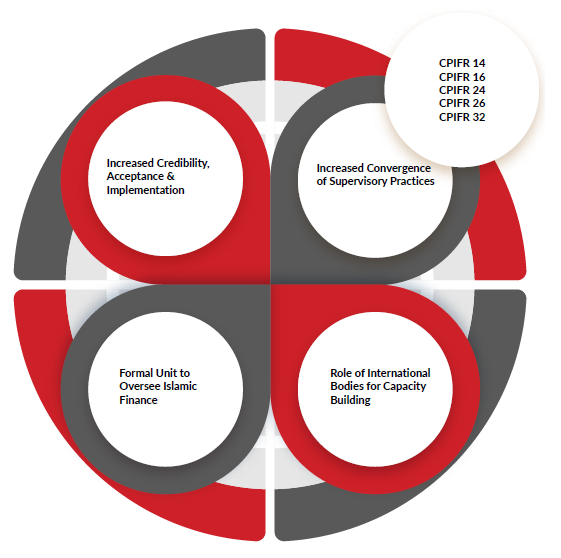Following the endorsement of the use of the IFSB’s Core Principles for Islamic Finance Regulation (CPIFR) and the associated assessment methodology for the Financial Sector Assessment Program (FSAP) by the IMF’s Executive Board on 24 May 2018, the subject has been a topic of much discussion among the Islamic finance fraternity.
Subsequently, from a regulatory perspective, there are several questions which have arisen, such as: how does this historic development propel the international recognition of Islamic finance’s robust regulatory eco-system; whether the implementation of the IFSB standards would increase; would there be an increased convergence in supervisory and regulatory practices; what should be done by the supervisors regulating Islamic banking to ensure that this impetus remains relevant for the industry.
This article attempts to address these questions and suggests the way forward for the industry.
It is imperative to highlight that the IMF’s engagement with Islamic finance is longstanding. Similar to the commonly held view in Islamic finance literature about the existence of Islamic finance specificities, the IMF has also acknowledged in its research and work that Islamic banks have distinct operations with differing risk profiles and balance sheet structures compared to conventional banks. Therefore, the approach to regulating and supervising Islamic banking should reflect the nature of risks to which Islamic banks are exposed. As such, would consequently require additional or different regulatory and supervisory practices.
“IT IS IMPERATIVE TO HIGHLIGHT THAT THE IMF’S ENGAGEMENT WITH ISLAMIC FINANCE IS LONGSTANDING”
For the past 20 years, the IMF has been cooperating fastidiously with many regulatory and supervisory authorities (RSAs) overseeing Islamic finance to provide technical advice as needed, and with other international organizations (e.g. World Bank, the Arab Monetary Fund, and the IsDB) as well as standard-setters on Islamic banking issues (e.g. IFSB and AAOIFI). It is important to recall that the IMF has played a central and catalytic role in the establishment of the IFSB in November 2002 in order to develop the necessary prudential standards for the Islamic financial services industry (IFSI). The IMF has since been an Associate Member of the IFSB.
According to the IFSB IFSI Financial Stability Report 2018, the global Islamic financial services industry (IFSI) continues to grow and evolve in size and complexity and has surpassed the US$2 trillion milestone in 2017 with an 8.3% growth in assets in US Dollar terms.1 Strong economic growth in core markets, persistent increasing demand for IFSI, regulatory improvements, and an enabling environment provided by governments and central banks continue to be the main drivers for the significant growth and development of the IFSI.
The Islamic banking sector, however, remains dominant. The sector is categorised as systemically important in 12 jurisdictions (Iran, Sudan, Brunei, KSA, Kuwait, Qatar, Malaysia, UAE, Bangladesh, Djibouti, Jordan, Bahrain), where the market shares have reached 15%. Collectively, these jurisdictions account for 92% of the global Islamic banking as- sets. On the other hand, market share in Pakistan, Oman, Egypt, Maldives, Indonesia, Turkey, and Tunisia remains between 5% to less than 15%.
IFSB CORE PRINCIPLES (CPIFR) AND STRUCTURE
The IFSB has a mandate to promote and enhance the soundness and stability of the IFSI by issuing global prudential standards and guiding principles for the industry, broadly defined to include Islamic banking, Islamic capital markets and Islamic insurance (Takaful). Similar to another international standard setter, the IFSB’s strength lies in its diverse membership. As at July 2018, the 182 members of the IFSB comprise 75 regulatory and supervisory authorities, eight international inter-governmental organisations (including the IMF, IsDB, BIS, ADB, and the World Bank), and 99 market players operating in 57 jurisdictions. Thus far, the IFSB has issued 27 Standards, Guiding Principles, as well as Guidance and Technical Notes. It is currently in the process of issuing three more standards by the end of 2018. The CPIFR is one of these 27 Standards, approved by the IFSB Council in April 2015. It is worth mentioning that besides the 23 regulators (central banks); the IMF, the World Bank, the Basel Committee, the IsDB, as well as the ADB were all part of the working group which prepared the CPIFR.
The CPIFR provides a minimum international standard for sound regulatory and supervisory practices for the effective supervision of the Islamic banks. Hence, CPIFR can assist all RSAs to carry out self-assessments of the progress made in the development of their regulatory frameworks and in achieving greater consistency in the implementation of the IFSB standards.
33 of the CPIFR are largely modeled after the Basel Core Principles for Effective Banking Supervision (BCP) as revised in September 2012, with modifications to address Islamic banking-specific issues in regulation and supervision in particular, with five additional principles and their corresponding methodology specific to Islamic banking operations. This is reflected in Figure 1.
Each CPIFR is supported by assessment criteria, which are divided into essential criteria (ECs) and additional criteria (ACs). In total, the additional number of ECs added by the IFSB are 72, mainly cover- ing prudential supervision, of which 46 are from four new principles. While 9 BCP are retained unamended in the CPIFR in view of their common applicability to both conventional and Islamic banking, 19 BCP have been amended at the level of the assessment criteria rather than the Principles themselves.
As per the IMF statement, the CPIFR and assessment methodology will be used in fully Islamic banking systems, and as a supplement to the BCP in dual banking systems where Islamic banking has a significant market share (of 15% or more). Where a jurisdiction has both significant Islamic banking and significant conventional banking sectors, the IMF will assess both sectors at the same time using the CPIFR and BCP standards and assessment methodologies respectively; which would reveal the relevant linkages between Islamic banking and its conventional counterpart, and their implications for financial stability.

“THE IFSB HAS A MANDATE TO PROMOTE AND ENHANCE THE SOUNDNESS AND STABILITY OF THE IFSI BY ISSUING GLOBAL PRUDENTIAL STANDARDS AND GUIDING PRINCIPLES FOR THE INDUSTRY, BROADLY DE- FINED TO IN- CLUDE ISLAMIC BANKING, ISLAMIC CAPI- TAL MARKETS AND ISLAMIC INSURANCE (TAKAFUL).”
Taking into account the aforementioned background and context, Figure 2 presents a brief response to the questions raised earlier, which are then discussed below in detail.
INCREASED CREDIBILITY, ACCEPTANCE AND IMPLEMENTATION
The IMF’s endorsement of the CPIFR will bring increased credibility, acceptance and implementation of Islamic finance globally by RSAs. There are 12 jurisdictions where Islamic banking accounts for more than 15% of the market share. Systemically important jurisdictions seem to be the primary beneficiaries of the IMF’s implementation of the CPIFR. They would subsequently serve as benchmarks for other jurisdictions where Islamic finance is yet to gain a market share of above 15%.
The CPIFR is a compendium of the IFSB standards covering a wide range of standards such as IFSB-1 (Risk Management), IFSB-3 (Corporate Governance), IFSB-10 (Shari‘ah Governance), IFSB-12 (Liquidity), IFSB-13 (Stress Testing), IFSB-15 (Revised Capital Adequacy), GN-6 (LCR and NSFR), and IFSB-16 (Pillar II). In this respect, compliance with CPIFR means that there will be an increased implementation of the IFSB standards by RSAs across jurisdictions. However, one should bear in mind that like the BCBS, the implementation of the IFSB standards by any jurisdiction is on a voluntary basis.
According to the IFSB Implementation Survey 2017, for the Islamic banking sector, five RSAs (15%) have implemented at least 70% of the standards; nine RSAs (28%) record an implementation rate of between 21%-70%; and 16 RSAs (50%) re- port a rate of 0%-20% implementation of the IFSB standards. While the first revelation is encouraging, the latter two showing lack of implementation represent a significant challenge. Interestingly, in the IFSB survey, the RSAs identified IFSB-15, GN-6, IFSB-12, IFSB-13 and IFSB-16 as presenting significant challenges in terms of implementation.
INCREASED CONVERGENCE OF SUPERVISORY PRACTICES
It is expected that as a result of compliance with CPIFR, there will be an increased convergence of supervisory practices for Islamic finance across the jurisdictions.



“ACCORD- ING TO THE IFSB’S RECENT SURVEY, 70% OF ALL ISLAMIC BANKS’ FINANCING ASSETS ARE CONCENTRATED ON MURABAHA OR SIMILAR CONTRACTS”
According to the recent IFSB survey, 51% of the respondents, i.e. the RSAs, found that introducing Regulatory Consistency Assessment against CPIFR across RSAs would be significant to support the implementation of the IFSB standards and highlight gaps in the supervisory framework.
In the academic literature and conferences, the lack of standardization and consistency in Islamic banking and supervisory practices has been repetitively acknowledged. As an example, lack of equity investment through Mudaraba and Musharaka contracts, and lack of clarity on the profit-sharing investment account (being one of the most significant funding sources for Islamic banks) has been widely attributed to the market players. Often, for some reasons, the RSAs are impugned for the lack of implementation guidance on these issues. Normally, the bottom-up approach is emphasized targeting the market players. However, the application of CPI- FR by various jurisdictions will create a top-down approach for ensuring consistency and convergence of supervisory practices. For illustration purposes, this is discussed in detail below.
First, for instance, it is common knowledge that the management of PSIA raises issues of governance, disclosure, and capital adequacy. In this regard, CPIFR 14 on PSIA will ensure how RSAs determine, from a prudential perspective, the treatment of PSIA by the Islamic banks in their respective jurisdiction (i.e. whether PSIA, as investors who bear all the earnings volatility and risks of losses, or as a liability of an Islamic bank, or as partially risk absorbent so that an Islamic bank bears part of the risk, aka, ‘al-pha factor’). The various implications – including the regulatory treatment, governance and disclosures, formation of profit equalization reserve or investment risk reserve, capital adequacy, and resolution framework – relating to PSIA across the jurisdictions will be sorted out by compliance to CPIFR 14.
Second, Shari’a compliance is central to ensuring the legality of contracts, and the integrity and credibility of Islamic banking operations as the risk of Shari’a non-compliance can lead not only to losses, but also to reputational risk. In this respect, the application of CPIFR 16 (Shari’a governance) will ensure that there are laws and regulations implemented by RSAs which require Islamic banks’ BODs to have a robust Shari’a governance system (including Shari’a Supervisory Board). Thus, ensuring an effective and independent oversight of Shari’a compliance over various structures covering both ex-ante and ex-post processes within the organisation.
Third, according to the IFSB’s recent survey, 70% of all Islamic banks’ financing assets are concentrated on Murabaha or similar contracts. However, equity investment through Mudarabah and Musharaka contracts (being one of the essential distinctive qualities of Islamic finance) only account for less than 5%. Hence, instead of focusing on Murabaha-like products, the focus should be on equity investment contracts. This would not only offer greater product diversification, productivity, and inclusiveness, but will also have a multiplier effect throughout the wider economy. Thus, compliance to CPIFR 24 (equity investment) will entail RSAs implement a top-down approach where laws and regulations will require Islamic banks to have in place adequate policies and procedures, strategies including valuation methodologies and exit strategies, and reporting processes for equity investment risk management.
WHAT IS REQUIRED?
Depending on the robustness of the institutional and regulatory infrastructure, the implementation of CPIFR will require varying degrees of effort and commitment from RSAs to achieve compliance. There are two factors that need to be highlighted.
First, there is a strong need to have a formal unit with a clear mandate within a central bank or supervisory authority to oversee Islamic finance operations. In many jurisdictions, according to the IFSB, Islamic banks are being supervised through existing arrangements or departments. In such jurisdictions, one of the first steps to be followed by RSAs is to ensure that there is a formal dedicated unit/section/department for the supervision of Islamic banks. This unit should ensure that there is adequate internal capacity and skill-sets to formulate and issue policies and regulations, and oversee their implementation in line with the IFSB prudential and AAOIFI accounting and Shari’a standards. For this to be realised the staff would require adequate knowledge of Islamic finance as a prerequisite in order for the unit to perform effectively, in particular when performing self-assessment using CPI- FR.
“FIRST, THERE IS A STRONG NEED TO HAVE A FORMAL UNIT WITH A CLEAR MAN- DATE WITHIN A CENTRAL BANK OR SUPERVISO- RY AUTHORITY TO OVERSEE ISLAMIC FINANCE OP- ERATIONS”
Islamic banks. This unit should ensure that there is adequate internal capacity and skill-sets to formulate and issue policies and regulations, and oversee their implementation in line with the IFSB prudential and AAOIFI accounting and Shari’a standards. For this to be realised the staff would require adequate knowledge of Islamic finance as a prerequisite in order for the unit to perform effectively, in particular when performing self-assessment using CPI- FR.
Without a formal structure, the efficacy of prudential regulation and supervision would be difficult to sustain in the long run. This unit should work closely with other departments within a supervisory authority in order to integrate Islamic finance with the financial system.
This approach is an integral part of establishing an Islamic finance eco-system not only for developing robust internal supervisory capacity, but also for preparing to export the expertise for IFSI. This is particular crucial when the IMF-World Bank FSAP will be implemented after January 2019, as they will need experts from relevant RSAs to participate in missions to undertake and support the quality of the assessments.
Second, there is a dire need to have effective coordination among Islamic finance bodies in terms of capacity building. Capacity building and the development of the supervisory resources is one of the key areas which should receive more attention from RSAs, as this will play a critical role in ensuring the compliance with CPIFR. Both BCP 2 and CPIFR 2 lay emphasis on the need for having adequate re- sources to conduct effective supervision and oversight.
In a recent IFSB survey, the two major challenges noted were the lack of “detailed knowledge of Islamic finance” and the length of time taken for the “process of standards implementation”. With respect to challenges in implementation, the IFSB survey reflects that 42% (16/38) of the respondent RSAs indicated, “our supervisory staff face challenge to supervise and assess the compliance with Islamic finance related regulations and guidelines, once is- sued” as significant, whereas, “implementation needs a detailed knowledge of Islamic finance, which few staff of our organisation have” was ranked as significant by 61% (23/38) of the RSAs.
To effectively deal with the challenges of implementation of CPIFR, RSAs should consider developing adequate human resource capacity to deal with CPIFR in terms of numbers and quality, given the peculiar nature of risks in Islamic banking. One way to ensure this is by encouraging concerted and collective efforts and collaboration for the implementation of IFSB standards. This should be done on global capacity development by international bodies such as the IFSB, the IsDB, IMF, CIBAFI, and regional credible training centres for capacity building of member countries. In this respect, supervisory-focused modules and trainings should be developed and conducted for central banks to achieve compliance with CPIFR.

CONCLUSION
The wider adoption of the CPIFR may require greater effort and better resources from supervisory authorities so as to achieve compliance across jurisdictions where Islamic banks operate under dual banking systems or otherwise. The IMF’s endorsement of the CPIFR is not just a momentous landmark for the IFSI. The CPIFR will help supervisory authorities in achieving consistency in supervisory surveillance and oversight, and an integrated prudential framework while complementing the international architecture for financial stability.
Having in place a formal structure of Islamic finance by the supervisors – where the Islamic finance unit is well-integrated with other organs such as policy affairs, supervision and surveillance, financial stability, and consumer protection – is pivotal to achieve long-term sustainability of Islamic finance growth, stability and resilience. In conclusion, despite the IMF’s adoption of the CPIFR, it is important to acknowledge that without concerted and collective effort by international bodies and stakeholders, the integration of Islamic finance globally would remain a challenge.



